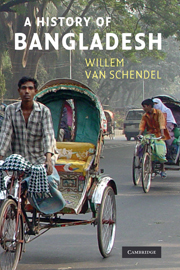Book contents
- Frontmatter
- Contents
- List of plates
- List of maps and figures
- Acknowledgements
- Timeline
- Introduction
- PART I THE LONG VIEW
- 1 A land of water and silt
- 2 Jungle, fields, cities and states
- 3 A region of multiple frontiers
- 4 The delta as a crossroads
- PART II COLONIAL ENCOUNTERS
- PART III BECOMING EAST PAKISTAN
- PART IV WAR AND THE BIRTH OF BANGLADESH
- PART V INDEPENDENT BANGLADESH
- Conclusion
- Bangladesh district maps
- Key political figures since 1947
- Glossary of Bengali terms
- Notes
- Bibliography
- Index
3 - A region of multiple frontiers
Published online by Cambridge University Press: 05 February 2015
- Frontmatter
- Contents
- List of plates
- List of maps and figures
- Acknowledgements
- Timeline
- Introduction
- PART I THE LONG VIEW
- 1 A land of water and silt
- 2 Jungle, fields, cities and states
- 3 A region of multiple frontiers
- 4 The delta as a crossroads
- PART II COLONIAL ENCOUNTERS
- PART III BECOMING EAST PAKISTAN
- PART IV WAR AND THE BIRTH OF BANGLADESH
- PART V INDEPENDENT BANGLADESH
- Conclusion
- Bangladesh district maps
- Key political figures since 1947
- Glossary of Bengali terms
- Notes
- Bibliography
- Index
Summary
The history of Bangladesh is a history of frontiers. From the earliest times the Bengal delta has been a meeting ground of opposites, and it is these encounters, clashes and accommodations that have given Bangladesh its distinct character. In this chapter I expand on Richard Eaton's idea of thinking about Bangladesh history as predicated upon a series of moving frontiers.
We have already encountered the land–water frontier – moving primarily from north to south – and the Sanskritic frontier – moving from west to east. Both are ancient and both are still very much part of contemporary Bangladesh. In this chapter we encounter four more frontiers, all of them historically moving in an easterly direction.
THE AGRARIAN FRONTIER
This frontier divides cultivators of irrigated fields from shifting cultivators and the forest. In the delta, embanked fields irrigated by monsoon rainwater and worked by ploughs appeared at least 2,500 years ago. Since then this form of crop production has been expanding gradually across the lowlands at the expense of an older system of hoe cultivation on temporary plots. Today the latter system is still found in Bangladesh, but is restricted to hill terrain where irrigated fields cannot be maintained.
The spread of irrigated agriculture was slow and uneven because establishing it requires much labour. Cultivators had to clear the forest, level the ground and construct field embankments and irrigation channels. Even more labour was needed to keep irrigated agriculture running. If successful, however, it was capable of permanently supporting dense populations.
- Type
- Chapter
- Information
- A History of Bangladesh , pp. 24 - 38Publisher: Cambridge University PressPrint publication year: 2009



